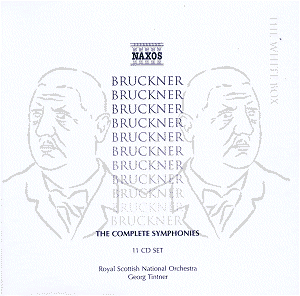At last Georg Tintnerís much discussed Bruckner Symphony
cycle has arrived complete, nicely packaged in one of Naxosís white
Boxes. The other seven White Boxes, recently launched, are also complete
symphonic cycles. Five of those employ a single orchestra. Tintner has
three at his disposal.
All the Bruckner symphonies in the pack have been released
separately over the last four years and reviews have already appeared
on this web site. Terry Barfoot has
taken an overview in addition to some separate reviews by others.
I will thus discuss the merits or otherwise of purchasing the complete
box.
What we have here is one manís view of a major body
of symphonic work so the enterprise hinges on Georg Tintner. Not all
conductors would be up to the job, to put it mildly. A true Brucknerian
is one who, among other things, can handle the brass blaze-ups, spiritually
plumbing adagios, rampant scherzi and so on yet keeps an absolute grip
on the overall architecture. Getting the most out of those passing moments
within a symphony yet leaving the listener with an impression (to use
an architectural metaphor) of a solid, well-buttressed cathedral is
no easy matter.
There is no question that Tintner is up to the job.
Some of the things he does may not be to everyoneís taste but he knows
exactly what he wants and how to get it. He certainly passes the test
mentioned above. So we come to the next factor in the success of this
venture, the orchestras - the players who have the responsibility to
realise Tintnerís vision. Potentially there could be a problem here.
If Bruckner fans were to pick their favourite symphony recordings they
are likely to come up with combinations of great Brucknerian conductors
with the great orchestras whose histories are partly bound up with the
music Ė the likes of The Vienna and Berlin Philharmonics. One of the
more recently recorded potent combinations has been Günter Wand
with the Berlin Philharmonic. Many people found his Seventh Symphony
breathtaking. Comparisons may be odious but people are going to
make them. Tintnerís three orchestras do a superb job but they are not
the Berlin Philharmonic. Tintnerís recording of the Seventh is, in my
opinion, the finest in the box. It reflects the unavoidable fact that
the playing of the Royal Scottish National Orchestra is a notch above
the other two orchestras. Nevertheless, the way the Berlin strings handle
the great opening tune under Wand really is incomparably breathtaking
in its perfection. Having said that, there are excitements in the Tintner
performance that move me more that in Wandís which turns the focus back
on our key factor Ė the conductor.
A third factor is the recording. I have long been convinced
that spacious vaulted cathedrals, organs, sacred choral music and God
were all merged and embedded in Brucknerís creative psyche. The symphonies
belong to that world. The music needs to find a space where the sound
can spread and soar heavenwards. Bruckner designed it so. This can be
achieved in some venues but is rarely approached in recordings. Maybe
it is impossible. Bearing that in mind, for me this set is recorded
rather close and the trumpets in particular come right at your face
often at the expense of the horns and Wagner tubas. Still, I cannot
have it both ways since I rarely get enough of the bright brass and
this approach helps to contribute to the excitement I mentioned in respect
of the Seventh. There seems to have been some conferring among engineers
across the three recording venues for there is an admirable consistency
of sound. There is splendid sonority and many people will like it very
much.
Another factor to take into account is the inclusion
of curiosities of particular interest to scholars. The complete (and
disowned!) "Study Symphony" and alternative versions
of two movements, the Third Adagio and Fourthís Finale,
are included. Which brings me to the thorny Bruckner "versions"
issue. Those interested in the composer could, on this subject, be categorised
into three: those who donít know too much and donít care, those who
think it a necessary chore and know a little, and those to whom it is
an all consuming interest (and are at risk of becoming Bruckner bores).
Of course it is an important issue and decisions have to be made. In
this case Tintner has made all the decisions based on a thorough knowledge,
as can be gathered from his booklet notes. Those who fall into the first
two categories can safely put themselves into Tintnerís hands. The experts
will see from the list which are the versions and will have their own
views. As a general principle Tintner tends towards Brucknerís earlier
thoughts where he feels it appropriate. In some cases this has led to
versions being included which are rarely heard. This applies particularly
to the First and Second symphonies and many people will
want to own these.
There is no question that this set is a major recording
achievement. For those who are fairly new to Bruckner and need a beginnerís
starter pack then this has to be it. Others who have incomplete collections
of the symphonies, then this is a marvellous way to fill the gaps. Lastly,
the seasoned fans will find here things of scholarly interest but in
purchasing the box will own performances that will provide competitive
alternatives to their old favourites. There is something for everyone
Ė a real quality bargain.
Georg Tintner spent much of his career in Australasia
and Canada so as a conductor he rarely got near mainstream centre stage.
The Bruckner set is bound to have a major impact on his reputation,
sadly a posthumous one for he died in 1999. This white box is a wonderful
epitaph.
John Leeman



![]() conductor: George Tintner
conductor: George Tintner
![]() NAXOS WHITE BOX 8.501101[12hrs:33mins]
NAXOS WHITE BOX 8.501101[12hrs:33mins]
![]() for
details
for
details